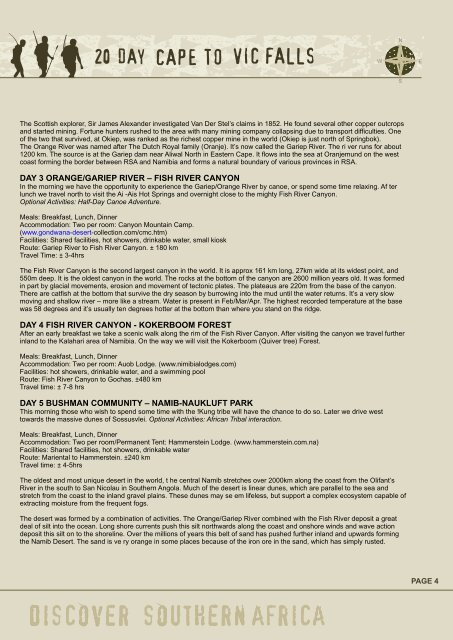20 DAY CAPE TO VIC FALLS - African Overland Safari Tours
20 DAY CAPE TO VIC FALLS - African Overland Safari Tours
20 DAY CAPE TO VIC FALLS - African Overland Safari Tours
You also want an ePaper? Increase the reach of your titles
YUMPU automatically turns print PDFs into web optimized ePapers that Google loves.
N<br />
W E<br />
The Scottish explorer, Sir James Alexander investigated Van Der Stel’s claims in 1852. He found several other copper outcrops<br />
and started mining. Fortune hunters rushed to the area with many mining company collapsing due to transport difficulties. One<br />
of the two that survived, at Okiep, was ranked as the richest copper mine in the world (Okiep is just north of Springbok).<br />
The Orange River was named after The Dutch Royal family (Oranje). It’s now called the Gariep River. The ri ver runs for about<br />
1<strong>20</strong>0 km. The source is at the Gariep dam near Aliwal North in Eastern Cape. It flows into the sea at Oranjemund on the west<br />
coast forming the border between RSA and Namibia and forms a natural boundary of various provinces in RSA.<br />
<strong>DAY</strong> 3 ORANGE/GARIEP RIVER – FISH RIVER CANYON<br />
In the morning we have the opportunity to experience the Gariep/Orange River by canoe, or spend some time relaxing. Af ter<br />
lunch we travel north to visit the Ai -Ais Hot Springs and overnight close to the mighty Fish River Canyon.<br />
Optional Activities: Half-Day Canoe Adventure.<br />
Meals: Breakfast, Lunch, Dinner<br />
Accommodation: Two per room: Canyon Mountain Camp.<br />
( www.gondwana-desert-collection.com/cmc.htm)<br />
Facilities: Shared facilities, hot showers, drinkable water, small kiosk<br />
Route: Gariep River to Fish River Canyon. ± 180 km<br />
Travel Time: ± 3-4hrs<br />
The Fish River Canyon is the second largest canyon in the world. It is approx 161 km long, 27km wide at its widest point, and<br />
550m deep. It is the oldest canyon in the world. The rocks at the bottom of the canyon are 2600 million years old. It was formed<br />
in part by glacial movements, erosion and movement of tectonic plates. The plateaus are 2<strong>20</strong>m from the base of the canyon.<br />
There are catfish at the bottom that survive the dry season by burrowing into the mud until the water returns. It’s a very slow<br />
moving and shallow river – more like a stream. Water is present in Feb/Mar/Apr. The highest recorded temperature at the base<br />
was 58 degrees and it’s usually ten degrees hotter at the bottom than where you stand on the ridge.<br />
<strong>DAY</strong> 4 FISH RIVER CANYON - KOKERBOOM FOREST<br />
After an early breakfast we take a scenic walk along the rim of the Fish River Canyon. After visiting the canyon we travel further<br />
inland to the Kalahari area of Namibia. On the way we will visit the Kokerboom (Quiver tree) Forest.<br />
Meals: Breakfast, Lunch, Dinner<br />
Accommodation: Two per room: Auob Lodge. (www.nimibialodges.com)<br />
Facilities: hot showers, drinkable water, and a swimming pool<br />
Route: Fish River Canyon to Gochas. ±480 km<br />
Travel time: ± 7-8 hrs<br />
<strong>DAY</strong> 5 BUSHMAN COMMUNITY – NAMIB-NAUKLUFT PARK<br />
This morning those who wish to spend some time with the !Kung tribe will have the chance to do so. Later we drive west<br />
towards the massive dunes of Sossusvlei. Optional Activities: <strong>African</strong> Tribal interaction.<br />
Meals: Breakfast, Lunch, Dinner<br />
Accommodation: Two per room/Permanent Tent: Hammerstein Lodge. (www.hammerstein.com.na)<br />
Facilities: Shared facilities, hot showers, drinkable water<br />
Route: Mariental to Hammerstein. ±240 km<br />
Travel time: ± 4-5hrs<br />
The oldest and most unique desert in the world, t he central Namib stretches over <strong>20</strong>00km along the coast from the Olifant’s<br />
River in the south to San Nicolau in Southern Angola. Much of the desert is linear dunes, which are parallel to the sea and<br />
stretch from the coast to the inland gravel plains. These dunes may se em lifeless, but support a complex ecosystem capable of<br />
extracting moisture from the frequent fogs.<br />
The desert was formed by a combination of activities. The Orange/Gariep River combined with the Fish River deposit a great<br />
deal of silt into the ocean. Long shore currents push this silt northwards along the coast and onshore winds and wave action<br />
deposit this silt on to the shoreline. Over the millions of years this belt of sand has pushed further inland and upwards forming<br />
the Namib Desert. The sand is ve ry orange in some places because of the iron ore in the sand, which has simply rusted.<br />
S<br />
PAGE 4


